- Joined
- Feb 2, 2011
- Messages
- 2,093
NEW RELEASES FOR DECEMBER 2024
THE EIGHTEENTH CENTURY COLLECTION
THE AMERICAN WAR OF INDEPENDENCE
THE BATTLE OF BUNKER HILL, 17th JUNE 1775.
THE ASSAULT ON THE REDOUBT AT BREED’S HILL
Boston was the third largest town in North America, and stood on a Peninsula connected to the mainland by a neck just wide enough to cross at high tide. The harbour, large enough to be strategically significant, and central to the town’s economy, was formed by a chain of islands stretching out to sea, guarded by reefs and ledges.
North west of Boston was Charlestown, a largely rural peninsula one and a half miles long. Charlestown stood at the south east corner with three hills behind it. Bunker’s Hill, nearest the neck of the Peninsula, Breed’s Hill 200 yards above the town and Moulton’s Hill to the north east.
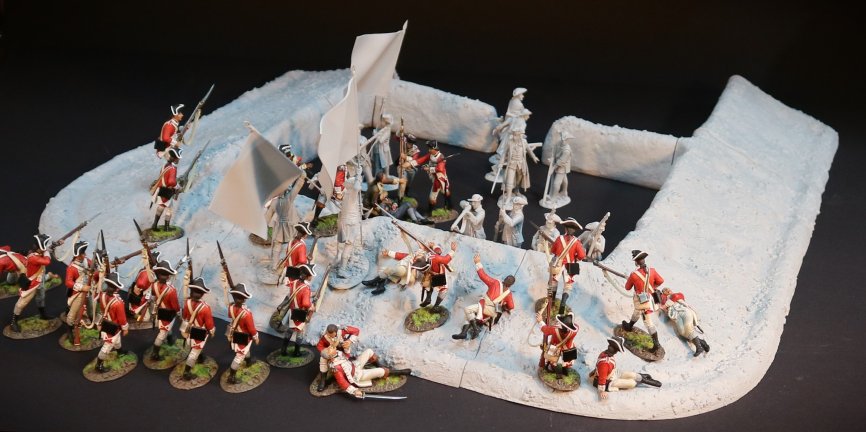
On the 16th June 1775, 3 detachments from Massachusetts regiments under the command of Colonel William Prescott and engineer Captain Richard Gridley, crossed the Charlestown neck and arrived at Bunker Hill.
Captain Richard Gridley and Prescott disagreed as to where they should locate their defense. Some work was performed on Bunker Hill, but Breed’s Hill was closer to Boston and viewed as being more defensible, and they decided to build their primary redoubt there.
Prescott and his men began digging a square fortification about 130 ft a side with ditches and earthen walls. The walls of the redoubt were about 6 feet high.
Work began at midnight, and around 4am one of the British warships spotted the earthworks on Breed’s Hill and opened fire.
The British command agreed that the works posed a significant threat, but were at this time sufficiently incomplete and isolated to offer a chance of a successful attack.
The original British plan was to bypass the redoubt to the north and capture Bunker’s Hill and the neck of the peninsula, thus isolating the redoubt on Breed’s Hill.
The Americans repulsed two British assaults, with significant British casualties. The British captured the redoubt on their third assault, after the defenders had run out of ammunition. The colonists retreated over Bunker Hill, leaving the British finally in control of the Peninsula.
The battle was a tactical victory for the British, but it proved to be a sobering experience for them; they incurred many more casualties than the Americans had sustained, including many officers. The battle had demonstrated that inexperienced militia were able to stand up to regular army troops in battle. Subsequently, the battle discouraged the British from any further frontal attacks against well defended front lines. American casualties were much fewer, although their losses included General Joseph Warren, and Major Andrew McClary, the final casualty of the battle.
THE AMERICAN ARMY
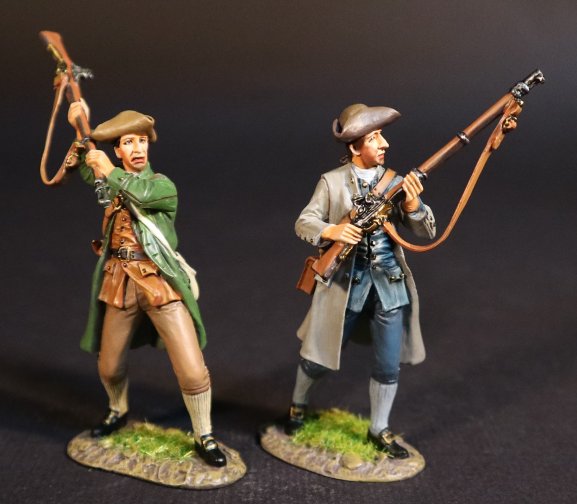
ABHL-05A
THE AMERICAN WAR OF INDEPENDENCE 1775-1783,
THE BATTLE OF BUNKER HILL, JUNE 17th 1775,
THE ASSAULT ON THE REDOUBT AT BREED’S HILL,
THE AMERICAN ARMY,
2 MINUTEMEN
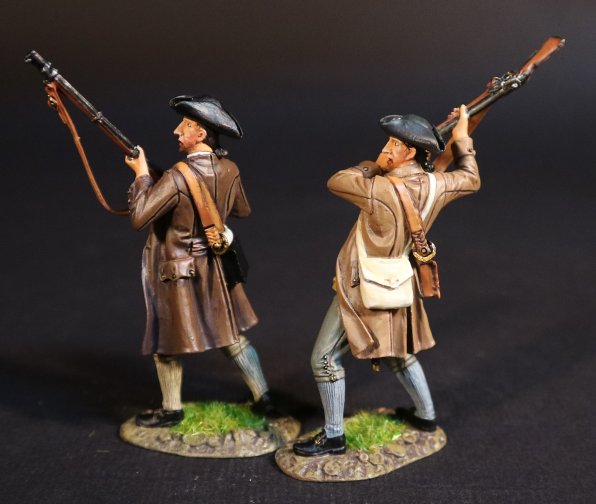
ABHL-05B
THE AMERICAN WAR OF INDEPENDENCE 1775-1783,
THE BATTLE OF BUNKER HILL, JUNE 17th 1775,
THE ASSAULT ON THE REDOUBT AT BREED’S HILL,
THE AMERICAN ARMY,
2 MINUTEMEN
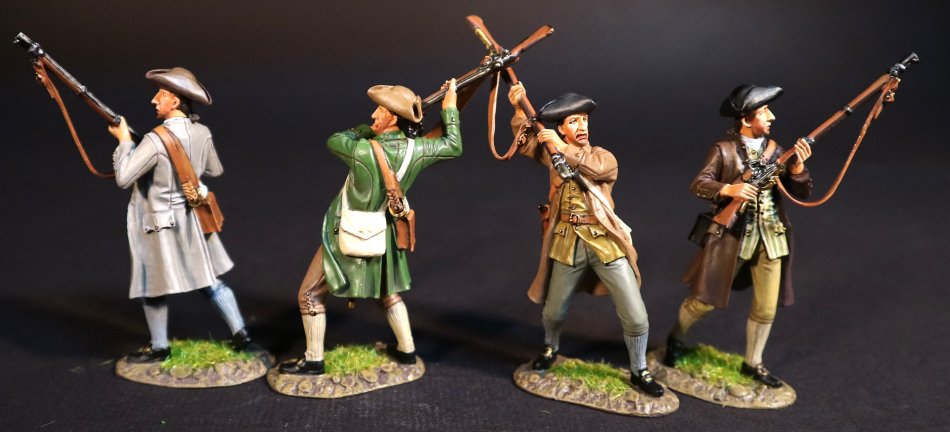
ABHL-05N
THE AMERICAN WAR OF INDEPENDENCE 1775-1783,
THE BATTLE OF BUNKER HILL, JUNE 17th 1775,
THE ASSAULT ON THE REDOUBT AT BREED’S HILL,
THE AMERICAN ARMY,
4 MINUTEMEN
BRITISH MARINES
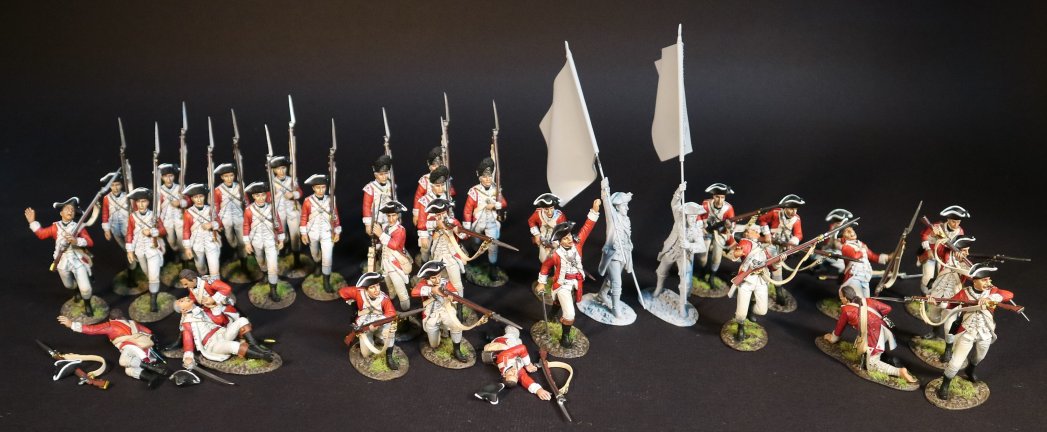
The Marines, which only became “Royal Marines” in 1802, were the Royal Navy’s private army, administered by the Admiralty and controlled by senior naval officers. The rank and file were volunteers and wore army style uniforms and equipment. However they were trained to serve on warships and undertake amphibious operations. The 50 companies, shared between Chatham, Portsmouth and Plymouth, were not regimented, and detachments, or in some cases individual replacements were assigned on an ad hoc basis.
The first Marines sent to Boston were to form a battalion of 600 men under Major Pitcairn, but by March only 336 were present, as they soon became an object of inter service rivalry over pay, food and conditions. Although initially physically inferior to their army comrades, and short of essential equipment for service on land, incessant drilling and regular marches into the countryside soon created a fine unit.
Another group of over 700 men arrived in May, and the whole force formed two battalions, with grenadier and light companies.
The 1st and 2nd Marines were to play an important part in the assault on the southern defences of the Breed’s Hill redoubt.
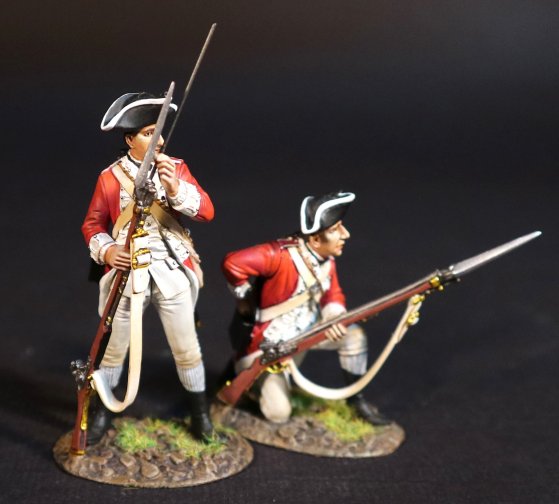
MBHL-10
THE AMERICAN WAR OF INDEPENDENCE 1775-1783,
THE BATTLE OF BUNKER HILL, JUNE 17th 1775,
THE ASSAULT ON THE REDOUBT AT BREED’S HILL,
BRITISH MARINES,
2 BRITISH MARINES
It was during one of the assaults by the 47th Regiment and the 1st Marines, that the American commander Prescott ordered his men to hold their fire until the British were within 30 yards. This action supposedly gave rise to the order, “Don’t fire till you see the whites of their eyes”!
The volley forced the Marines and regulars back out of range to regroup.
Adjutant, Lieutenant Waller, managed to reform two companies, and with the 47th Regiment on their left, the two battalions finally swarmed over the defences and into the redoubt, probably being the first troops to enter.
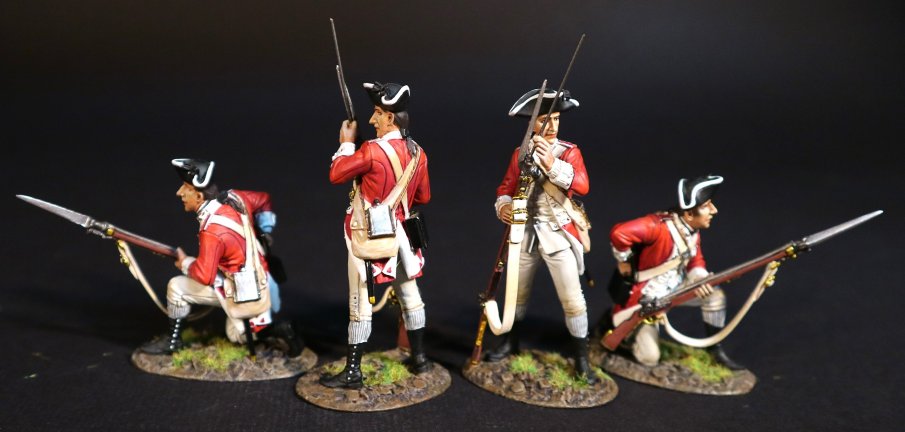
MBHL-10N
THE AMERICAN WAR OF INDEPENDENCE 1775-1783,
THE BATTLE OF BUNKER HILL, JUNE 17th 1775,
THE ASSAULT ON THE REDOUBT AT BREED’S HILL,
BRITISH MARINES,
4 BRITISH MARINES
This third attack was made at the point of the bayonet and successfully carried the redoubt. However the final volleys of fire from the colonists cost the life of Major Pitcairn. The defenders had run out of ammunition, redusing the battle to close combat. The advantage turned to the British as their troops were equipped with bayonets on their muskets, while most of the colonists were not.
Colonel Prescott, one of the last men to leave the redoubt, parried bayonet thrusts with his normally ceremonial saber.
THE SEVEN YEARS WAR
THE THIRD CARNATIC WAR 1756-1763
THE BATTLE OF WANDEWASH, 22nd JANUARY 1760
THE BRITISH ARMY
The Battle of Wandewash was a confrontation between the French under the command of The Comte de Lally, and the British Sir Eyre Coote. It was the decisive battle in the Anglo French struggle in southern India during the Seven Years War.
Lally, cut off from sea support by the withdrawal of Admiral d’Aché’s fleet and hampered by a lack of funds and by dissensions among his troops, tried to recover the fort of Wandiwash near Pondicherry.
There he was attacked and routed by Coote, with about 1,700 British troops against about 2,000 French. Lally’s best general, the marquis de Bussy, was captured. The French were thereafter confined to Pondicherry, which surrendered on Jan. 16, 1761, after much privation. Lally was later imprisoned and executed, after a trial in Paris, for alleged treason
The following two British regular units served in India and were present at the battle of Wandewash. It should be noted however that it was rare for these units to serve as complete battalions, and that they were generally broken up into detachments.
THE 84th (COOTE’S) REGIMENT OF FOOT
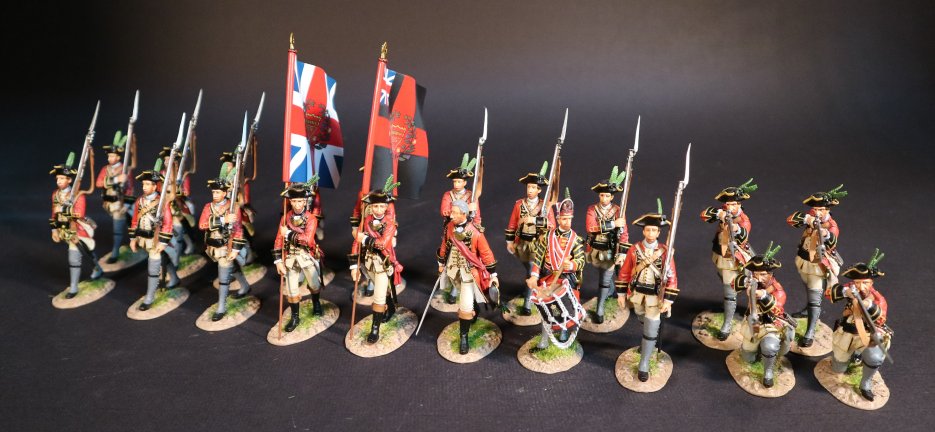
The 84th (Coote’s) Regiment was raised in January 1759, specifically for service in India.
The regiment was ordered home to be disbanded in 1764, but was instead reduced in India and most of the personnel were to enter the East India Company service.
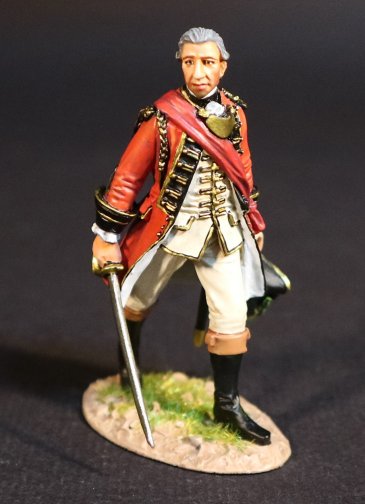
WB84-01
THE SEVEN YEARS WAR,
THE THIRD CARNATIC WAR 1756-1763,
THE BATTLE OF WANDEWASH, 22nd JANUARY 1760,
THE BRITISH ARMY,
84th (COOTE’S) REGIMENT OF FOOT,
OFFICER
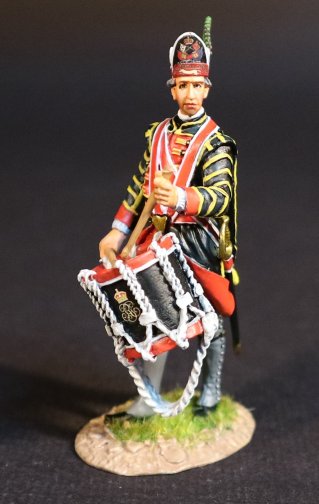
WB84-04
THE SEVEN YEARS WAR,
THE THIRD CARNATIC WAR 1756-1763,
THE BATTLE OF WANDEWASH, 22nd JANUARY 1760,
THE BRITISH ARMY,
84th (COOTE’S) REGIMENT OF FOOT,
DRUMMER
** PLEASE CONTACT YOUR LOCAL DEALER FOR FURTHER INFORMATION **
THE EIGHTEENTH CENTURY COLLECTION
THE AMERICAN WAR OF INDEPENDENCE
THE BATTLE OF BUNKER HILL, 17th JUNE 1775.
THE ASSAULT ON THE REDOUBT AT BREED’S HILL
Boston was the third largest town in North America, and stood on a Peninsula connected to the mainland by a neck just wide enough to cross at high tide. The harbour, large enough to be strategically significant, and central to the town’s economy, was formed by a chain of islands stretching out to sea, guarded by reefs and ledges.
North west of Boston was Charlestown, a largely rural peninsula one and a half miles long. Charlestown stood at the south east corner with three hills behind it. Bunker’s Hill, nearest the neck of the Peninsula, Breed’s Hill 200 yards above the town and Moulton’s Hill to the north east.

On the 16th June 1775, 3 detachments from Massachusetts regiments under the command of Colonel William Prescott and engineer Captain Richard Gridley, crossed the Charlestown neck and arrived at Bunker Hill.
Captain Richard Gridley and Prescott disagreed as to where they should locate their defense. Some work was performed on Bunker Hill, but Breed’s Hill was closer to Boston and viewed as being more defensible, and they decided to build their primary redoubt there.
Prescott and his men began digging a square fortification about 130 ft a side with ditches and earthen walls. The walls of the redoubt were about 6 feet high.
Work began at midnight, and around 4am one of the British warships spotted the earthworks on Breed’s Hill and opened fire.
The British command agreed that the works posed a significant threat, but were at this time sufficiently incomplete and isolated to offer a chance of a successful attack.
The original British plan was to bypass the redoubt to the north and capture Bunker’s Hill and the neck of the peninsula, thus isolating the redoubt on Breed’s Hill.
The Americans repulsed two British assaults, with significant British casualties. The British captured the redoubt on their third assault, after the defenders had run out of ammunition. The colonists retreated over Bunker Hill, leaving the British finally in control of the Peninsula.
The battle was a tactical victory for the British, but it proved to be a sobering experience for them; they incurred many more casualties than the Americans had sustained, including many officers. The battle had demonstrated that inexperienced militia were able to stand up to regular army troops in battle. Subsequently, the battle discouraged the British from any further frontal attacks against well defended front lines. American casualties were much fewer, although their losses included General Joseph Warren, and Major Andrew McClary, the final casualty of the battle.
THE AMERICAN ARMY

ABHL-05A
THE AMERICAN WAR OF INDEPENDENCE 1775-1783,
THE BATTLE OF BUNKER HILL, JUNE 17th 1775,
THE ASSAULT ON THE REDOUBT AT BREED’S HILL,
THE AMERICAN ARMY,
2 MINUTEMEN

ABHL-05B
THE AMERICAN WAR OF INDEPENDENCE 1775-1783,
THE BATTLE OF BUNKER HILL, JUNE 17th 1775,
THE ASSAULT ON THE REDOUBT AT BREED’S HILL,
THE AMERICAN ARMY,
2 MINUTEMEN

ABHL-05N
THE AMERICAN WAR OF INDEPENDENCE 1775-1783,
THE BATTLE OF BUNKER HILL, JUNE 17th 1775,
THE ASSAULT ON THE REDOUBT AT BREED’S HILL,
THE AMERICAN ARMY,
4 MINUTEMEN
BRITISH MARINES

The Marines, which only became “Royal Marines” in 1802, were the Royal Navy’s private army, administered by the Admiralty and controlled by senior naval officers. The rank and file were volunteers and wore army style uniforms and equipment. However they were trained to serve on warships and undertake amphibious operations. The 50 companies, shared between Chatham, Portsmouth and Plymouth, were not regimented, and detachments, or in some cases individual replacements were assigned on an ad hoc basis.
The first Marines sent to Boston were to form a battalion of 600 men under Major Pitcairn, but by March only 336 were present, as they soon became an object of inter service rivalry over pay, food and conditions. Although initially physically inferior to their army comrades, and short of essential equipment for service on land, incessant drilling and regular marches into the countryside soon created a fine unit.
Another group of over 700 men arrived in May, and the whole force formed two battalions, with grenadier and light companies.
The 1st and 2nd Marines were to play an important part in the assault on the southern defences of the Breed’s Hill redoubt.

MBHL-10
THE AMERICAN WAR OF INDEPENDENCE 1775-1783,
THE BATTLE OF BUNKER HILL, JUNE 17th 1775,
THE ASSAULT ON THE REDOUBT AT BREED’S HILL,
BRITISH MARINES,
2 BRITISH MARINES
It was during one of the assaults by the 47th Regiment and the 1st Marines, that the American commander Prescott ordered his men to hold their fire until the British were within 30 yards. This action supposedly gave rise to the order, “Don’t fire till you see the whites of their eyes”!
The volley forced the Marines and regulars back out of range to regroup.
Adjutant, Lieutenant Waller, managed to reform two companies, and with the 47th Regiment on their left, the two battalions finally swarmed over the defences and into the redoubt, probably being the first troops to enter.

MBHL-10N
THE AMERICAN WAR OF INDEPENDENCE 1775-1783,
THE BATTLE OF BUNKER HILL, JUNE 17th 1775,
THE ASSAULT ON THE REDOUBT AT BREED’S HILL,
BRITISH MARINES,
4 BRITISH MARINES
This third attack was made at the point of the bayonet and successfully carried the redoubt. However the final volleys of fire from the colonists cost the life of Major Pitcairn. The defenders had run out of ammunition, redusing the battle to close combat. The advantage turned to the British as their troops were equipped with bayonets on their muskets, while most of the colonists were not.
Colonel Prescott, one of the last men to leave the redoubt, parried bayonet thrusts with his normally ceremonial saber.
THE SEVEN YEARS WAR
THE THIRD CARNATIC WAR 1756-1763
THE BATTLE OF WANDEWASH, 22nd JANUARY 1760
THE BRITISH ARMY
The Battle of Wandewash was a confrontation between the French under the command of The Comte de Lally, and the British Sir Eyre Coote. It was the decisive battle in the Anglo French struggle in southern India during the Seven Years War.
Lally, cut off from sea support by the withdrawal of Admiral d’Aché’s fleet and hampered by a lack of funds and by dissensions among his troops, tried to recover the fort of Wandiwash near Pondicherry.
There he was attacked and routed by Coote, with about 1,700 British troops against about 2,000 French. Lally’s best general, the marquis de Bussy, was captured. The French were thereafter confined to Pondicherry, which surrendered on Jan. 16, 1761, after much privation. Lally was later imprisoned and executed, after a trial in Paris, for alleged treason
The following two British regular units served in India and were present at the battle of Wandewash. It should be noted however that it was rare for these units to serve as complete battalions, and that they were generally broken up into detachments.
THE 84th (COOTE’S) REGIMENT OF FOOT

The 84th (Coote’s) Regiment was raised in January 1759, specifically for service in India.
The regiment was ordered home to be disbanded in 1764, but was instead reduced in India and most of the personnel were to enter the East India Company service.

WB84-01
THE SEVEN YEARS WAR,
THE THIRD CARNATIC WAR 1756-1763,
THE BATTLE OF WANDEWASH, 22nd JANUARY 1760,
THE BRITISH ARMY,
84th (COOTE’S) REGIMENT OF FOOT,
OFFICER

WB84-04
THE SEVEN YEARS WAR,
THE THIRD CARNATIC WAR 1756-1763,
THE BATTLE OF WANDEWASH, 22nd JANUARY 1760,
THE BRITISH ARMY,
84th (COOTE’S) REGIMENT OF FOOT,
DRUMMER
** PLEASE CONTACT YOUR LOCAL DEALER FOR FURTHER INFORMATION **

